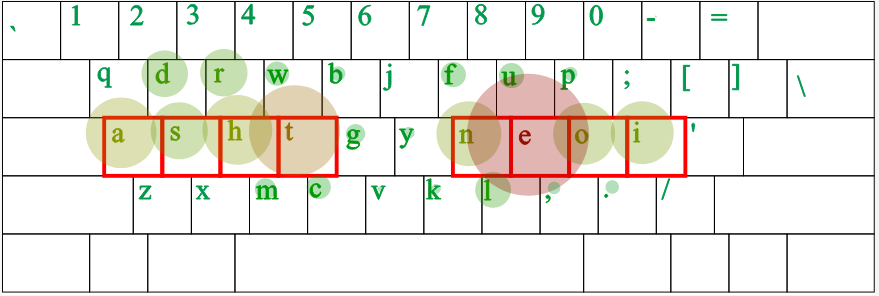Workman Keyboard Layout (2010)
Workman Keyboard Layout
Workman layout is created by OJ Bucao, in 2010.
He didn't like Dvorak, and complains that in Colemak Layout (2005), there are too much moving of index finger to the center 2 columns, in particular moving to the Colemak h.
Workman layout began the idea that lateral movement for index finger is bad. (that is, index finger should not move to the middle much.)

The Story of the Workman Keyboard Layout
Here is his story on why it is invented. Excerpt from 〔A Different Philosophy in Designing Keyboard Layouts By OJ Bucao. @ http://viralintrospection.wordpress.com/2010/09/06/a-different-philosophy-in-designing-keyboard-layouts/ 〕
Being a programmer, I type a lot and I suffer from Repetitive Strain Injury (RSI) and tendonitis on my wrist. …
The first alternative keyboard layout that came to mind is Dvorak. It was created in the 1930′s and promised to be vastly superior to QWERTY. I went ahead and tried it out and soon enough after doing “ls -latr” on the terminal, I had to shake my head and sadly walk away from it. I didnt like the way Dvorak was laid out especially for the weak fingers of the right hand.
…
Then I stumbled upon a layout called Colemak, …
My initial excitement turned to disappointment when I realized that even though my fingers were not moving up and down as much, it was moving too much laterally. I realized that the main culprit was the letter ‘H’ placed to the right of the letters ‘N’ and ‘E’. ‘N’ is where your index finger rests. Typing ‘HE’ forced the hand to make a very unnatural sideways twisting motion from the wrist and then back again. To give you an idea on why this could be serious, consider these:
- ‘HE’ is the second most frequent bigram in the English language (‘TH’ is the first).
- It occurs in approximately 8,188 words.
- You type it approximately once every 26 keystrokes, or once in every 5 words.
- At 40wpm, you will make this movement 8 times in one minute. More if you are faster.
Just ask yourself, how often do you type ‘the’, ‘these’, ‘them’, ‘when’, and ‘where’, etc. on a day-to-day basis? It's even worse when you're typing these words in the beginning of a sentence. Try typing “The” with the T capitalized on Colemak and hopefully you'll see what I mean. Your right hand will move somewhat like this: you swing to the right to get the SHIFT key with your pinky, then you swing back to the left to get the letter ‘H’, and then you move to the right again to get the letter ‘E’. All this is happening in a split second. …
I was really disappointed that Colemak was not the layout that I had hoped it would be. I no longer wanted to use QWERTY. I didn't like Dvorak, and the other alternatives didn't look very promising either – but rather very alien. I really wanted Colemak to work however I can't live with the H-E movement and having to reach for D and H often. I felt that it could be made better. …
I decided to try to create a new keyboard layout based on these ideas. …
I call it the Workman Keyboard Layout in honor of all who type on keyboards for a living. And considering that today is Labor Day, I think it's perfectly fitting.
The Workman Layout Homepage
2018-07-09 http://www.workmanlayout.org/
2018-07-09 https://github.com/ojbucao/Workman
Keyboard layout design
- Keyboard Layout Design 🔠
-
Ergonomic keyboard Layouts
-
Thumb Keyboard Layouts
- Most Efficient Layout?
- QWERTY Layout
- Dvorak Layout
- Maltron vs Dvorak
- Colemak Layout (2005)
- Workman Layout (2010)